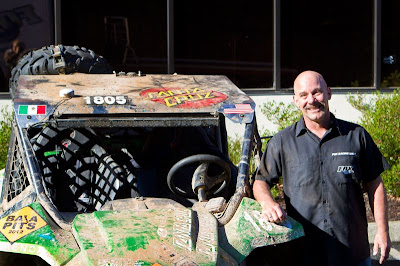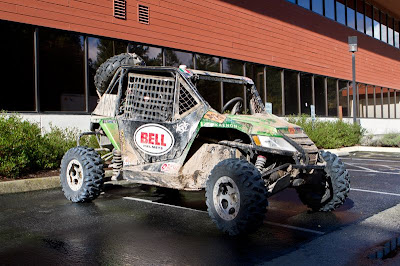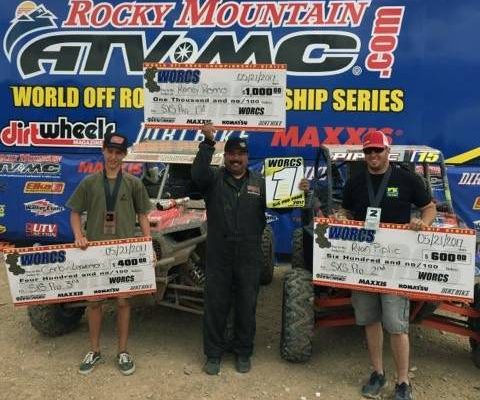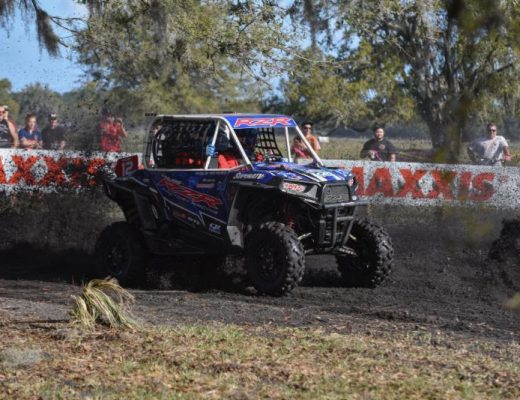 |
| Mike Grinder and the Arctic Cat Wildcat that completed the Baja 1000 |
By Mike Grinder FOX Shop Planner/Scheduler
Ever since I was a young boy I have been captivated by events that showcase extremes in human and mechanical endurance. Automobile and motorcycle racing have always been a dream of mine, but besides racing motocross years ago, I have never had the opportunity to participate in a big event.
One such event that has always captured my attention was the SCORE Baja offroad racing series. Six months ago my brother, Eric Pucelik, called to ask if I was interested in joining a team he was putting together to race an Arctic Cat Wildcat in this years Baja 1000. Here was my chance to live one of my life-long dreams. Our plan was to put together a vehicle that would be dependable enough for us to finish.
We were repeatedly told that if we were serious about finishing the race we should choose another vehicle. No team had completed a Baja 1000 point-to-point race in a Wildcat. Eric had done some pre-running in a Wildcat earlier this year; he thought if we did our homework and upgraded the appropriate components, we would have a good chance of finishing the race.
 |
| Arctic Cat Wildcat 1000 |
With the help of our teammate Dave Broome, we replaced the roll cage using Wildcat Willys racing cage as well as the company’s clutch cooling fan, a Harmon custom fuel cell, custom brake rotors and limit straps.
We upgraded the tires and wheels using ITP bead lock wheels and Maxxis Bighorn 2.0 tires and replaced the rear axles with Rhino brand heavy duty axles. We upgraded the stock skid plates with Factory UTV’s half-inch UHMW skid plates and front A-arm guards, DragonFire seats and harnesses, and High Lifters upper and lower radiused rear suspension links.
We added a fresh air helmet system, in-car intercom, Lowrance navigation system and window netting. It was decided to keep the engine stock to increase our chances of finishing.
 |
| FOX 2.5 PODIUM-X shocks with Bottom-Out Control |
I contacted Wes Allinger and asked if FOX would be interested in providing us with shocks for our Cat. Fortunately, FOX was looking for test platforms for some new shocks that were in the works, and our race run would be a great way to test the endurance of the new shocks. Grant Skognes and Regan Woelfel built up some shocks for us; we got the shocks in time to run them in the race.
We headed to Ensenada, Mexico on November 7 with two additional teammates: Casey Lyons as one of our navigators and Zach as our support vehicle driver. We finally got some time to test the vehicle over the weekend and got the shocks tuned for the rugged terrain of the Baja peninsula.
We started the race on Thursday, November 15 at 12:03 p.m., as the fourth-from-the-last vehicle on the course. The Wildcat performed flawlessly with no mechanical problems.
We signed up for the Baja Pits, a service with locations about every 50 miles throughout the race where tools, welders and fuel are provided for any team that wants to use its services. We signed up for fuel at every stop.
I ended up driving through the infamous silt beds. This was one of the few places in the race where the Wildcats four-wheel-drive was critical. After completing this section, we ended up having to replace one of the rear axles due to a torn CV boot. Since it was one of the items wed practiced replacing, we were able to change the axle in less than 10 minutes.
At around race mile 650, we pulled into the Baja Pits for fuel. One of the other buggy teams had broken down and decided to withdraw from the race. One of their crew was helping with the fueling. Unfortunately, he wasn’t paying attention to the type of fuel container he was supposed to use to fuel our vehicle and ended up dumping about three gallons of gas all over the back of the Wildcat. The fuel burst into flames.
Eric and I were sitting in the car with the window nets up and our harnesses buckled. The fire engulfed the whole back of the car and my shoulder and helmet. We struggled to get out of the car, and luckily the pit crew put the fire out before there was too much damage to the car or us.
I escaped from the ordeal with a blister on my neck. Now I know why SCORE is so adamant about wearing fire protective driving suits. Unfortunately, the fire had burned the rear wiring harness. The guys in the Baja Pits taped up the wiring the best they could, and we were on our way.
Two miles down the road the Wildcat started sputtering. We got out of the car and saw that the electrical tape was falling off the wires because they had not been cleaned of all the fire extinguisher powder. Our toolkit had been the only fatality of the fire, so we ended up using medical tape to insulate the bare wires. We were underway once again.
We quickly realized that when they had put out the fire, they had sprayed a bunch of the extinguisher powder into the open fuel fill hose. From this point on, we were unable to run the car at full throttle for more than a few seconds before it started to starve for fuel. The in-tank fuel filter was partially clogged.
Dave and Casey took over driving at around race mile 850. It was in the middle of a very rocky section of the racecourse. They hit a large boulder and broke one of the rear wheels. They replaced the tire and wheel with a spare that was being carried on the car, but the battery had drained and the Wildcat wouldn’t start.
They called us on the satellite phone and told us where they were stuck. We were about 100 miles away from the nearest highway crossing at this point. Eric and I told them we were on our way and that we would ride one of our motorcycles in so that they would not have to spend the night in the middle of nowhere.
At this point we had let go of finishing the race and were only concerned with the well-being of our teammates. Twenty minutes before we got to the place where the track crossed the highway we got another call from them telling us that they were on the move again. Dave had jumped the Wildcat using two Makita drill batteries. This earned him the MacGyver award for the race. We were back in the race!
Eric, Zach and I were waiting at the finish line on Saturday morning. Talking to the SCORE officials we were told that our car would be the last vehicle to finish the race before they closed the course. The fuel delivery problem had gotten worse. Their top speed at this point was less than 30 mph. The next 45 minutes were the most nerve-wracking minutes of my life, wondering if they were still moving and whether they were going to make it to the finish line before the course was closed.
Every competitor had 45 hours to complete the course. Dave and Casey crossed the finish line at 44:46:44, with less than 14 minutes to spare, and took third place in the Sport UTV class in the Baja 1000! It also turns out that we were the first Arctic Cat Wildcat to ever finish the Baja 1000. Not only had we finished, but we earned a place on the podium for our efforts.
I want to thank everyone who helped us achieve this amazing result. Ive heard other Baja finishers say that once you’ve completed the Baja 1000, life seems much easier. I never realized quite what was meant by this, but now that Ive experienced this achievement, I understand what a profound effect completing the Baja 1000 has had on me.
More shock details: 2.5 PODIUM-X W/Bottom-Out Control
Follow us on Facebook at www.facebook.com/UTVGuide



No Comments